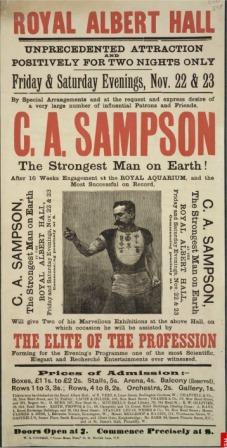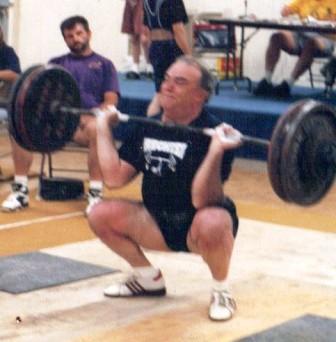The Day Sandow Beat Sampson
by Al Myers
I enjoy reading about Old-Time Strongmen. It is interesting learning about their training, their show performances, and even their rivalries with other Strongmen. You have to remember that there were no structured competitions for lifters to compete against each other in that day (late 1800’s and early 1900’s). Often several Strongmen in the same generation would promote themselves as “the Worlds Strongest Man”, which logic tells us can not be true! There can be only one. Today, this question is answered yearly, and with EVERYONE able to witness it on television, as the “Worlds Strongest Man” is settled amongst the best professional strongmen in the World. Of course, the argument could be made that someone who didn’t compete in this Strongman Competition was stronger, but that it not the point. The point is that this TITLE is crowned on only one man every year.
All Old-Time Strongmen made their living off of giving performances. Their “strongman acts” usually involved feats of strength, mixed with a little theatrics. The best performers were actors in every sense. They would “build up” the crowd with their strength stunts, and once performed, the crowd would lavish them with applause and admiration. These guys knew how to sell tickets, and would do anything to “pack the house”. One of their ploys was offering “challenges” to other Strongmen – and put up wagers to increase the significance of the challenge. If no one shows – all the better, as these Strongmen would pump their chest and say everyone else was afraid to “take them on” and use this statement to back up their claim as “the Worlds Strongest Man”. Sort of like winning by default. But occasionally, a well-known Strongman would take another well-known Strongman up on “their Challenge”, resulting in a make or break confrontation. Someone would win and someone would loss – thus the beginning of competitive weightlifting competitions.
This day happened on November 2nd, 1889 when the famous Eugen Sandow decided to take up Charles “Samson” Sampson on his challenge, and refute Sampson’s claim as the “strongest man on earth”. To make a long story short, Sandow came out on top as he completed ALL of Sampson’s challenges, and was declared the winner. This was one of Sandow’s most talked about victories over a rival strongman, but the details behind this dual are often left out with the mention of his “beating Sampson”. I recently read Sandow’s book, Strength and how to obtain it, and Sampson’s book, Strength, and found many discrepancies between the two of them on their reports of this challenge. The old adage, “there are two sides to every story”, is so true in trying to re-tell this story. I will try to do my best to represent the opinions of both Sandow and Sampson. Now on to the story!
Sampson was performing at the Royal Aquarium in London when this challenge was issued by him – 500 pounds of his money versus 100 pounds of the challenger, that the challenger could not duplicate the feats used in his (Sampson’s) strongman act. However, Sandow said Sampson was putting up 1000 pounds instead of 500, which in the end didn’t really matter as Sampson reneged on his payment, and Sandow had to settle with the Aquarium for a small settlement. When Sandow’s manager, Professor Attila, notified Sampson that Sandow wanted to take up his challenge that evening, Sampson postponed it till the next Saturday evening. Sandow said “Sampson wasn’t prepared to meet me” while Sampson said it was for promotional purposes. Thus the disagreements on the reflections on this challenge begins between the two of them.
The next Saturday evening the house is packed, with a reported 10,oo0 people in attendance. Standing room only. So full they locked the doors to prevent more people from crowding in (apparently there were no fire codes in those days!). When Sandow arrived 20 minutes before the challenge was to start he found himself locked out! He kept trying to get in but the door guard had orders not to let anyone else in. Finally the hour the challenge was to begin had arrived, and Sandow was still not present, as he was locked outside. Whether this was done by intention of Sampson is uncertain, but when Sandow heard Sampson proclaiming to the impatient crowd, “Ah – see. He does not come! I thought he would not meet me!”, Sandow decided to use his brawn instead of his negotiating skills and broke the door down! What an entrance that must have been!
Two very important dignitaries were appointed the judges by the Aquarium – Marquis of Queensberry and Lord de Clifford. After inspection by these officials – the challenge began. Sampson had to know that he was no match for Sandow involving barbell strength, as he chose these three challenges first- bending a pipe over his arm and leg, breaking a wire around his chest by chest expansion, and breaking a chain around his upper arm by flexing. Sandow repeated the first two with ease as he described, but with great difficulty as Sampson described. The real drama occurred during the third challenge. Sampson placed a chain armlet around his upper arm and broke it by flexing his arm. However, when he gave a chain armlet to Sandow with the exact same measurements Sandow could not get it over his arm as he was a larger man. This was Sampson’s “ace in the hole” challenge as he knew it would not “fit” Sandow’s arm, and as he was proclaiming his win to the crowd Sandow pulled an identical chain armlet from his pocket, only longer. The judges looked it over and said it looked the same as Sampsons. Sandow even had a representative of the company present at the show that sold the chains. Sandow called him up to the stage, and after this “expert” looked over the chain, he declared it was the same chain Sampson used. The judges HAD to agree now in allowing Sandow to use his own chain. Sandow then broke it with ease. It seems obvious to me that Sandow had “scouted” out Sampson’s act and was prepared for everything. Sampson latter said Sandow’s chain must have been specially made with a weak link, or he had someone in the crowd “switch it” out for a weaker chain as it was passed around for the crowds inspections after the judges inspection. Sampson really thought he had Sandow on this one. Now, getting desperate, Sampson produced a leather strap which he was going to break with chest expansion. Sandow appealed to the judges that this stunt was not part of Sampson’s act, as it wasn’t, and the challenge specifically stated it had to be a feat done in his act. The judges agreed leaving Sampson speechless. At this point, Sandow seized the moment and demanded his money since he had met all of the challenges. Sandow quickly produced a 280 pound dumbell, took it overhead with one arm, laid down with it, and then stood up again. Quite an impressive Full-Gardner Lift! Sandow told Sampson if he or his sidekick Cyclops could do that feat he would let them keep their money. Sampson, knowing he couldn’t, proclaimed, “I have had enough of this, It’s all humbug, I don’t call this fair play at all”. He then went to his locker room, leaving Sandow to the cheering crowd and his well-orchestrated victory. The good news is that this defeat didn’t end Sampson’s Strongman career, as he continued to put on shows for several years. He even signed off in his book as “Still the strongest on Earth”.

